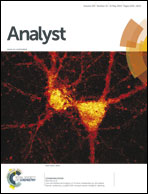Selective visual detection of trace trinitrotoluene residues based on dual-color fluorescence of graphene oxide–nanocrystals hybrid probe†
Abstract
Herein, for the detection of highly explosive 2,4,6-trinitrotoluene (TNT) instantly and on-site, a fluorescence ratiometric probe using a dual-emission nanohybrid has been developed. The nanohybrid comprises blue-colored fluorescent graphene oxide (FGO) being conjugated with red-emitting manganese-doped ZnS nanocrystals (ZnS:Mn NCs), the latter being functionalized with hexamethylenediamine. The blue fluorescence of FGO is insensitive to TNT and is used as an internal reference, whereas the red fluorescence of ZnS:Mn NCs can be selectively quenched by TNT through electron transfer, resulting in a unique red–purple–blue color response as the amount of TNT is increased. Thus, the probe could be used for the quantitative measurement of TNT based on the fluorescence ratiometric method. We demonstrated that the nanohybrid probe exhibited high visual detection sensitivity and reliability in comparison with single-color fluorescence quenching probes. A fluorescence test paper was prepared using the nanohybrid probe and was demonstrated to detect TNT residues directly on various surfaces including rubber, a person's fingers and manila envelopes with a visual detection limit as low as 5.68 ng mm−2, showing its promising application for security screening.


 Please wait while we load your content...
Please wait while we load your content...